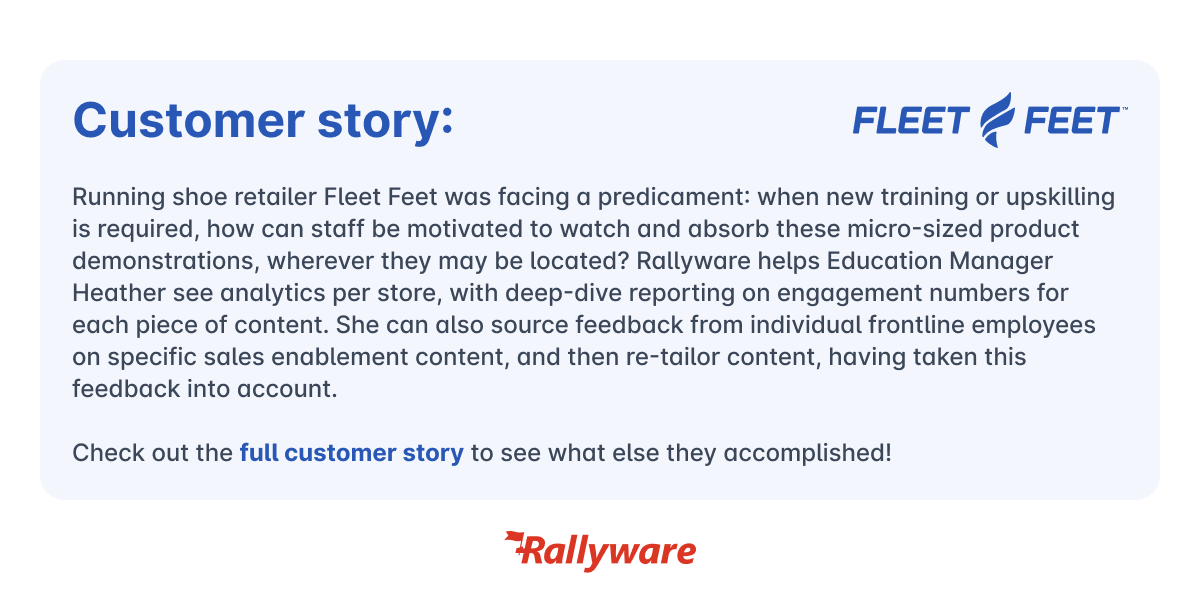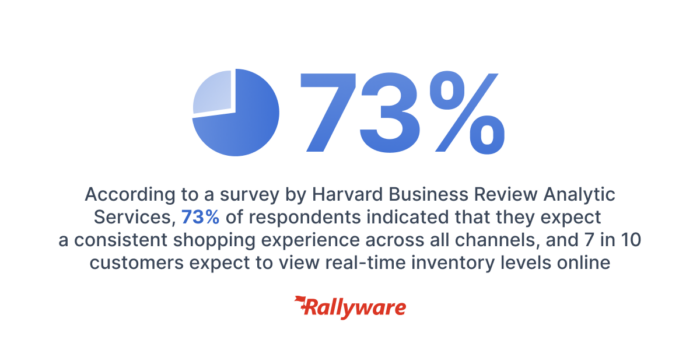Top 5 Sales Enablement Metrics to Measure in 2024
3 Trends Set to Boost Retail Sales in 2024
Retailers today are feeling the squeeze amidst economic headwinds, shifting customer loyalty patterns, and pressure to pay higher wages. These challenges have been around for a while, and many retailers have already tried all the usual ways to cut costs. But in this environment, retailers can’t just raise prices to recoup losses. So, how are industry leaders thinking about how to boost sales in retail in 2024?
Win on CX with Automation to Boost Retail Sales
In 2024, retailers are shifting their automation priorities from tick-the-boxes operational enhancements to reimagining the customer experience by freeing up bandwidth for sales associates. While people often assume that automation leads to job losses, when automated systems take over tasks like restocking, fulfillment services, and checkout, more resources become available to focus on providing great service both online and in physical stores.
One big trend in 2024 for organizations looking to boost sales in retail is making online interactions, well, more interactive. For example, companies like Klarna and Bonobos connect customers’ online chats with in-store employees who can help with detailed questions. Some luxury apps even offer concierge services or assistance after a purchase. Studies show that around 30% of customers feel that having knowledgeable staff is an important factor in building loyalty.
Moreover, performance enablement technologies have never been more robust. These automation technologies allow sales associates to provide personalized recommendations and better track inventory availability, which improves the overall in-store experience. We know that customer satisfaction in physical stores is greatly influenced by the quality of service, and automation will be crucial in 2024 in the battle for loyalty.

Personalization and service are huge parts of the loyalty and retention equation, but let’s not undervalue efficiency and convenience in the question of how to boost sales in retail.
In certain Walgreens pharmacies, robots are used to fill prescriptions faster and with fewer errors compared to human pharmacists. This helps address the shortage of healthcare workers and reduces the risk of mistakes that could harm patients. Self-service kiosks are also being used to shorten wait times and provide answers to common questions. This allows employees to focus on more complex inquiries and provide faster service in other ways, further contributing to the quest to boost retail sales.
Now, let’s go over opportunities for omnichannel personalization. But first, we have to define what omnichannel shopping is.
What Is Omnichanel Shopping?
Omnichannel shopping refers to a retail strategy that provides a seamless and integrated shopping experience across multiple channels, both online and offline, to create a unified and cohesive customer experience. The goal of omnichannel shopping is to enable consumers to interact with a brand or retailer dynamically, with multiple touchpoings including physical stores, eCommerce websites, mobile apps, social media, and more. All the while, the brand or retailer should maintain consistency in product branding, pricing, and customer service.
One important statistic that illustrates the significance of omnichannel shopping is the increase in consumer expectations for a seamless shopping experience:
According to a survey by Harvard Business Review Analytic Services, 73% of respondents indicated that they expect a consistent shopping experience across all channels. 7 in 10 customers expect to view real-time inventory levels online. In other words, they expect linearity. This statistic shows the growing importance of omnichannel approaches for retailers and brands, as failing to meet these expectations can result in a loss of customers, an erosion of brand image, and a decline in revenue.

Max Out Personalized Omnichannel
Providing a great experience across different shopping channels used to be seen as a cutting-edge approach in retail. Now, it’s something retailers must do to stay in the game. Since the pandemic, over one-third of Americans have regularly used omnichannel features like buying online and picking up in-store. And almost two-thirds of those people plan to keep using these features in the future.
Younger shoppers are especially excited about new ways of shopping. McKinsey research shows that most Gen Z consumers don’t even think about traditional shopping boundaries. They care more about how seamless and smooth their shopping experience is when evaluating brands and stores. To boost sales in retail, organizations must cater to these expectations.
While most retailers personalize their messages and interactions to some extent, those that aim for omnichannel personalization go beyond basic retargeting and segmenting customers. They create personalized experiences across different channels, and they do it consistently and on a large scale.
Take Sephora, for example. They offer customers personalized messages within their app, customized push notifications, and the option to book in-person beauty consultations using their smartphones. In their stores, technology allows their staff to access a customer’s favorite products and recommend new ones based on their profile. Customers can also use scanners to find products that match their specific hair color and skin type. Sephora’s loyalty program, Beauty Insider, uses customer data from different channels to offer coordinated promotions via email, website, and mobile, boosting retail sales both online and in-store.
Achieving this level of personalization requires advanced data management and process integration, but it helps Sephora capture more value.
Sephora discovered that customers who visited their website within 24 hours of visiting the store were three times more likely to make a purchase, and their order values were 13% higher compared to other customers. This insight allowed Sephora to invest wisely in their online engagement strategies. Overall, Sephora reported record sales in 2020 for their omnichannel business and plans to expand their physical stores in the future. Anyone looking to boost sales in retail would do well to learn from their example.
Scale Technology for Lifestyle Shopping
Instead of just having occasional interactions with a store, consumers now embrace omnichannel ecosystems as part of their everyday lives. These ecosystems provide a wide range of content, offers, and community interactions. It’s like having a continuous relationship with the brand.
This approach can bring many benefits. For example, Nike has apps like SNKRS and Run Club that not only offer products but also organize meet-ups, running groups, and events. Their Training Club app provides personalized workouts and fitness programs. By investing in these experiences, Nike goes beyond just selling shoes and clothes and becomes a part of people’s daily routines, all of which ultimately contributes to boosting retail sales.
These omnichannel ecosystems also help retailers explore new business models. For instance, Starbucks has been investing in mobile ordering, payments, rewards, and personalized experiences for over a decade. This has resulted in more than $1 billion in prepaid deposits from customers. With this capital, Starbucks can venture into new areas and enhance the experiences they offer.
Why Retail Sales Will Be in Trouble in 2024
Frontline employee engagement and retention, along changing customer behaviours and preferences, will continue to be issues that retailers face in 2024. Retailers are leaning into new technologies and innovations to improve the customer experience, yet the key is to focus on the frontline employees themselves – how can you transform them into top performers?
Performance enablement technology makes it easier for sellers to be more productive, and boosts sales – recent Rallyware data indicates that sellers who were actively using their performance enablement technology had 21% higher sales than those less actively engaged with the platform. These sellers also had a 3X higher average order size than their less-active counterparts.
To see how world-renowned brands like Nike and Casio increase retail sales with performance enablement, check out a demo of Rallyware’s platform!
News and Insights on Workforce Training & Engagement
We’re among top-notch eLearning and business engagement platforms recognized for effective training and talent development, helping to empower distributed workforces
Subscribe
